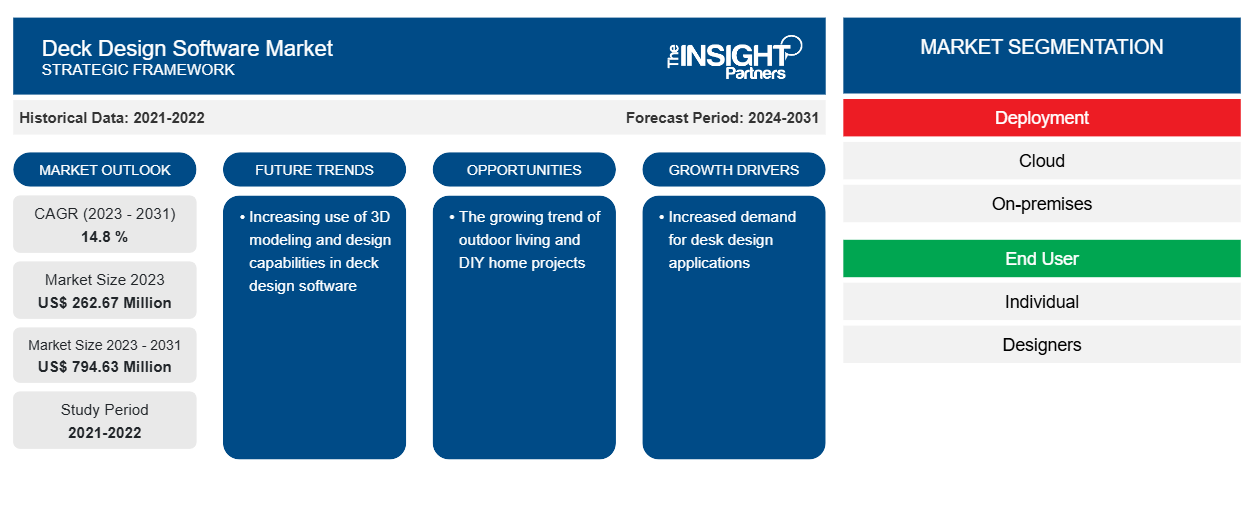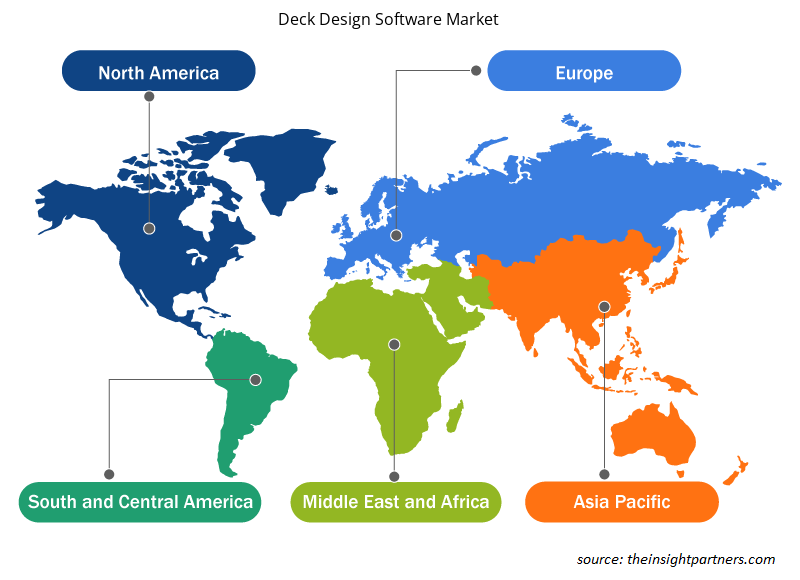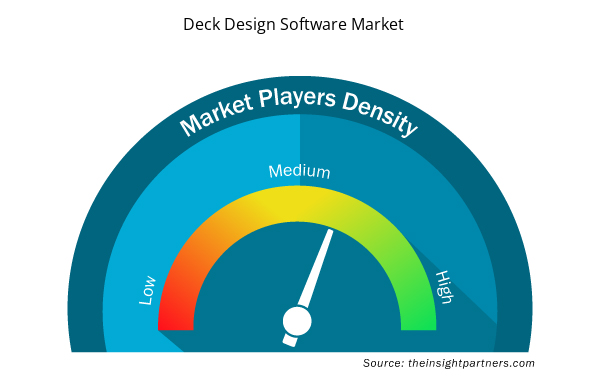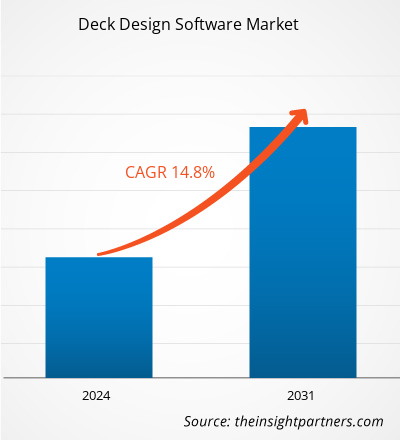The deck design software market size is projected to reach US$ 794.63 million by 2031 from US$ 262.67 million in 2023. The market is expected to register a CAGR of 14.8 % in 2023–2031. Increasing use of 3D modeling and design capabilities in deck design software is likely to remain a key deck design software market trend.
Deck Design Software Market Analysis
The rising use of these tools in the construction and home remodeling sectors is predicted to drive significant growth in the global deck design software market. More people are attempting to update their outdoor living areas. The market is anticipated to rise as a result of the rising popularity of outdoor decking and the accessibility of high-tech deck tools. Furthermore, it is anticipated that growing worries about safety as a result of natural disasters may increase demand for deck design software. Deck design software is growing in popularity as the industry drives toward a future that is more mechanized and digitalized. Professionals frequently use it because of its many capabilities, which include 3D visualization, automatic drafting, and effective project management.
Deck Design Software Market Overview
An electronic tool for planning, designing, and visualizing outdoor decks is deck design software. With the help of this kind of software, you can make, alter, and design decks in a variety of sizes and forms. You can also take pictures of the 3D design and send them to clients or coworkers. In order to guarantee that deck structures satisfy industry standards and safety regulations, deck design software has also been utilized in the engineering process.
Customize This Report To Suit Your Requirement
You will get customization on any report - free of charge - including parts of this report, or country-level analysis, Excel Data pack, as well as avail great offers and discounts for start-ups & universities
Deck Design Software Market: Strategic Insights

- Get Top Key Market Trends of this report.This FREE sample will include data analysis, ranging from market trends to estimates and forecasts.
You will get customization on any report - free of charge - including parts of this report, or country-level analysis, Excel Data pack, as well as avail great offers and discounts for start-ups & universities
Deck Design Software Market: Strategic Insights

- Get Top Key Market Trends of this report.This FREE sample will include data analysis, ranging from market trends to estimates and forecasts.
Deck Design Software Market Drivers and Opportunities
Increased demand for desk design applications
The need for deck design applications is growing as more and more homeowners and contractors want to be able to plan and envision their decks before they begin building. With deck design software, users may quickly and easily change the deck's size or shape, experiment with numerous design possibilities, and see the finished product in three dimensions. This facilitates the process of planning and building decks and lessens the need for costly in-person discussions with contractors.
The growing trend of outdoor living and DIY home projects
Deck design software is becoming more and more popular as a result of the expanding trends of outdoor living and do-it-yourself home improvements. An increasing number of homeowners are doing do-it-yourself projects, such as building decks and outdoor kitchens, to enhance their outdoor living areas. With the use of deck design software, homeowners can more easily and precisely plan and visualize their deck before beginning construction, potentially saving money and time on the project. Thus, the increasing adoption of IoT is anticipated to present new opportunities for the deck design software market players during the forecast period.
Deck Design Software Market Report Segmentation Analysis
Key segments that contributed to the derivation of the deck design software market analysis are deployment, end user, and application.
- Based on the deployment, the deck design software market is segmented into cloud and on-premises. The cloud segment held a larger market share in 2023.
By end user, the market is segmented into individuals and designers.
- By application, the market is segmented into residential and commercial.
Deck Design Software Market Share Analysis by Geography
The geographic scope of the deck design software market report is mainly divided into five regions: North America, Asia Pacific, Europe, Middle East & Africa, and South America/South & Central America. In terms of revenue, North America accounted for the largest deck design software market share. These days, a lot of businesses provide software that is specifically designed for the North American market, which makes it simpler for customers to locate the ideal item for their requirements. Furthermore, the growing accessibility of online resources is propelling the market. To help them get the most out of their investment, consumers may now access a variety of videos, advice, and tips on using deck design software.
Deck Design Software Market Regional Insights
The regional trends and factors influencing the Deck Design Software Market throughout the forecast period have been thoroughly explained by the analysts at Insight Partners. This section also discusses Deck Design Software Market segments and geography across North America, Europe, Asia Pacific, Middle East and Africa, and South and Central America.

- Get the Regional Specific Data for Deck Design Software Market
Deck Design Software Market Report Scope
| Report Attribute | Details |
|---|---|
| Market size in 2023 | US$ 262.67 Million |
| Market Size by 2031 | US$ 794.63 Million |
| Global CAGR (2023 - 2031) | 14.8 % |
| Historical Data | 2021-2022 |
| Forecast period | 2024-2031 |
| Segments Covered |
By Deployment
|
| Regions and Countries Covered | North America
|
| Market leaders and key company profiles |
Deck Design Software Market Players Density: Understanding Its Impact on Business Dynamics
The Deck Design Software Market is growing rapidly, driven by increasing end-user demand due to factors such as evolving consumer preferences, technological advancements, and greater awareness of the product's benefits. As demand rises, businesses are expanding their offerings, innovating to meet consumer needs, and capitalizing on emerging trends, which further fuels market growth.
Market players density refers to the distribution of firms or companies operating within a particular market or industry. It indicates how many competitors (market players) are present in a given market space relative to its size or total market value.
Major Companies operating in the Deck Design Software Market are:
- AZEK Building Products (Timber Tech)
- Chief Architect Inc.
- Delta Software International LLC (CAD Pro)
- Fiberon
- Idea Spectrum, Inc
- Luxwood Software Tools
Disclaimer: The companies listed above are not ranked in any particular order.

- Get the Deck Design Software Market top key players overview
Deck Design Software Market News and Recent Developments
The deck design software market is evaluated by gathering qualitative and quantitative data post primary and secondary research, which includes important corporate publications, association data, and databases. The following is a list of developments in the market for speech and language disorders and strategies:
- In 2021, the TimberTech Pro Reserve Collection is a new range of composite decking materials that the company introduced. The series has improved moisture and stain resistance, a 30-year warranty, and a realistic wood look and feel. With the variety of colors and patterns in the collection, consumers can develop personalized and distinctive deck layouts. (Source: TimberTech, Press Release)
- In October 2021, Fiberon announced the launch of Deck Designer which is the newest addition to the Discovery Deck Design Tools suite of interactive digital resources for homeowners and trade professionals. Deck Designer is a 3D design tool that facilitates users to design an outdoor living space using the full offering of railing, Fiberon decking, and cladding products. (Source: Fiberon, Press Release)
Deck Design Software Market Report Coverage and Deliverables
The “Deck Design Software Market Size and Forecast (2021–2031)” report provides a detailed analysis of the market covering below areas:
- Market size and forecast at global, regional, and country levels for all the key market segments covered under the scope
- Market dynamics such as drivers, restraints, and key opportunities
- Key future trends
- Detailed PEST/Porter’s Five Forces and SWOT analysis
- Global and regional market analysis covering key market trends, major players, regulations, and recent market developments
- Industry landscape and competition analysis covering market concentration, heat map analysis, prominent players, and recent developments
- Detailed company profiles
- Historical Analysis (2 Years), Base Year, Forecast (7 Years) with CAGR
- PEST and SWOT Analysis
- Market Size Value / Volume - Global, Regional, Country
- Industry and Competitive Landscape
- Excel Dataset



Report Coverage
Revenue forecast, Company Analysis, Industry landscape, Growth factors, and Trends

Segment Covered
Deployment , End User , and Application

Regional Scope
North America, Europe, Asia Pacific, Middle East & Africa, South & Central America

Country Scope
Argentina, Australia, Brazil, Canada, China, France, Germany, India, Italy, Japan, Mexico, Russian Federation, Saudi Arabia, South Africa, South Korea, United Arab Emirates, United Kingdom, United States
Frequently Asked Questions
What will be the market size of the global deck design software market by 2031?
The global deck design software market is expected to reach US$ 794.63 million by 2031.
Which are the key players holding the major market share of the global deck design software market?
The key players holding majority shares in the global deck design software market are AZEK Building Products (Timber Tech), Chief Architect, Inc., Delta Software International LLC (CAD Pro), Fiberon, and Idea Spectrum, Inc.
What are the future trends of the global deck design software market?
The increasing use of 3D modeling and design capabilities in deck design software is anticipated to play a significant role in the global deck design software market in the coming years.
What are the driving factors impacting the global deck design software market?
The increased demand for desk design applications and the growing trend of outdoor living and DIY home projects are the major factors that propel the global deck design software market.
What is the estimated market size for the global deck design software market in 2023?
The global deck design software market was estimated to be US$ 262.67 million in 2023 and is expected to grow at a CAGR of 14.8 % during the forecast period 2023 - 2031.

 Get Free Sample For
Get Free Sample For